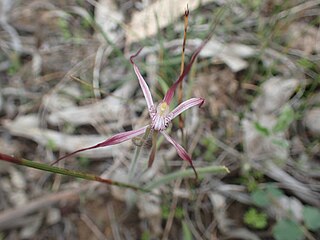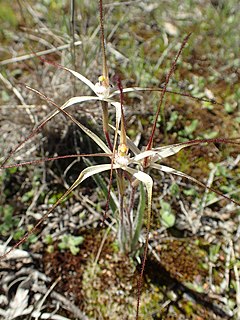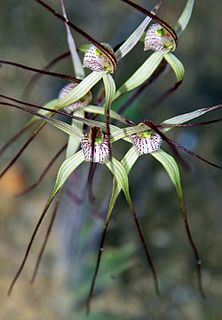
Caladenia cruscula, commonly known as the reclining spider orchid is a species of orchid endemic to a small area in the south-west of Western Australia. It has a single hairy leaf and a single cream-coloured flower with a long red fringe on the sides of its labellum.

Caladenia fluvialis, commonly known as the Brookton Highway spider orchid is a species of orchid endemic to the south-west of Western Australia. It is a recently discovered orchid with a single hairy leaf and one or two cream-yellow flowers with red markings on the labellum.

Caladenia footeana, commonly known as the crimson spider orchid is a species of orchid endemic to the south-west of Western Australia. It has a single, hairy leaf and one or two, relatively small pinkish-red flowers with a white, red-striped labellum. Its relatively small size makes it hard to find in its surroundings.

Caladenia gardneri, commonly known as the cherry spider orchid, is a species of orchid endemic to the south-west of Western Australia. It has a single, hairy leaf and up to three pale pink, sweetly scented flowers with a dark pinkish-red labellum.

Caladenia heberleana, commonly known as Heberle's spider orchid, is a species of orchid endemic to the south-west of Western Australia. It has a single, hairy leaf and up to three red, white and pale yellow flowers which have a white, red-tipped labellum.

Caladenia horistes, commonly known as the cream spider orchid is a species of orchid endemic to the south-west of Western Australia. It has a single, hairy leaf and one or two, creamy-yellow flowers which have a red-striped labellum and long, dark, thread-like tips on the sepals and petals.
Caladenia meridionalis, commonly known as the south coast spider orchid, is a species of orchid endemic to the south-west of Western Australia. It is an early-flowering orchid with a single erect, hairy leaf and one or two white flowers with long, drooping lateral sepals and petals.

Caladenia occidentalis, commonly known as the ruby spider orchid, is a species of orchid endemic to the south-west of Western Australia. It has a single erect, hairy leaf and one or two pinkish-red flowers with a white, red-striped labellum.

Caladenia paradoxa, commonly known as the ironcaps spider orchid, is a species of orchid endemic to the south-west of Western Australia. It has a single erect, hairy leaf and up to three small creamy-white flowers. It was previously thought to be the same species as the eastern Australian Caladenia flaccida but is now recognised as distinct.

Caladenia pendens subsp. pendens, commonly known as the pendant spider orchid, is a plant in the orchid family Orchidaceae and is endemic to the south-west of Western Australia. It has a single hairy leaf and up to three relatively large, creamy-white flowers with long drooping petals and sepals and sometimes has a sickly-sweet scent.
Caladenia perangusta, commonly known as the Boyup Brook spider orchid, is a species of orchid endemic to the south-west of Western Australia. It is a rare spider orchid with a single hairy leaf and one or two cream-yellow or red flowers with narrow, drooping sepals and petals.
Caladenia pholcoidea subsp. pholcoidea, commonly known as the Albany spider orchid, is a plant in the orchid family Orchidaceae and is endemic to the south-west of Western Australia. It has a single hairy leaf and up to four pale yellow flowers with long drooping petals and lateral sepals.
Caladenia pluvialis, commonly known as the Yuna spider orchid, is a species of orchid endemic to the south-west of Western Australia. It is a common spider orchid, especially after winter rains, occurring in a restricted area. It has a single hairy leaf and one or two creamy-coloured flowers. It was formerly included with Caladenia incensa.
Caladenia remota subsp. remota, commonly known as the outback spider orchid, is a plant in the orchid family Orchidaceae and is endemic to the south-west of Western Australia. It has a single hairy leaf and one or two relatively large creamy-white to pale yellow flowers. It is relatively common in moist soil around granite outcrops, growing in more inland areas than most other spider orchids.

Caladenia remota subsp. parva, commonly known as the Perenjori spider orchid, is a plant in the orchid family Orchidaceae and is endemic to the south-west of Western Australia. It has a single hairy leaf and up to three creamy-white to pale yellow flowers. It has a more restricted and more westerly distribution than subspecies remota.
Caladenia saxicola, commonly known as the banded ironstone spider orchid is a plant in the orchid family Orchidaceae and is endemic to the south-west of Western Australia. It has a single erect, hairy leaf and one or two dull creamy-white to pale yellow flowers with spreading lateral sepals and petals.
Caladenia ultima, commonly known as the late spider orchid, is a species of orchid endemic to the south-west of Western Australia. It has a single erect, hairy leaf and up to three creamy-yellow flowers with a red-striped labellum. It is one of the last spiders orchids to flower each year.
Caladenia validinervia, commonly known as the Lake Muir spider orchid, is a species of orchid endemic to the south-west of Western Australia. It has a single erect, hairy leaf and up to three greenish to creamy white flowers with red stripes on the sepals and petals. The flowers have relatively narrow sepals and petals and a relatively small labellum. It is a rare orchid only known from an area between Rocky Gully and Collie.

Caladenia vulgata, commonly known as the common spider orchid, is a species of orchid endemic to the south-west of Western Australia. It is a relatively common and widespread orchid with a single erect, hairy leaf and up to three creamy-white flowers. There is some variation in the species, both in flower colour and growth habit.
Caladenia xantha, commonly known as the primrose spider orchid, is a species of orchid endemic to the south-west of Western Australia. It has a single erect, hairy leaf and up to three yellow flowers with a cream-coloured, brown-striped labellum.











